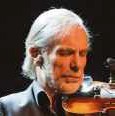
PHOTO KEVIN RAYMOND.
Renaissance’ was the second track on my 1976 album Aurora. I had no idea at the time that it was going to be my first big success, or that it would still be played on radio today – it wasn’t my intention to write a hit, as I’ve never known how! It’s hard for me to say why it took off the way it did: I think that somehow the piece looked back to my youth, and had a kind of European feel that might have appealed to people.
It was conceived in a different way from anything else I’d ever composed. I was flying back to Los Angeles after finishing a European tour, and the first few bars of the piece came into my head. That’s happened before, but this time I could hear the specific instrumentation – the melody was being played pizzicato on a violin, while a cimbalom was performing the same line alongside it. I’d been to Eastern Europe in the mid-1960s and heard gypsy bands playing with a cimbalom, so I must have picked it up from there. Then a few days later, while I was driving through LA, I heard the next eight bars, then another sixteen, and it all stayed with me. Several weeks after that, we were recording Aurora in the studio and even though I knew this piece didn’t fit with anything else on the album, I decided to record it. I ditched the electric violin I used on the other tracks, and picked up the Charles Jacquot that my parents bought me when I started at the Paris Conservatoire. I found an autoharp, which was the closest equivalent to a cimbalom that I could find in Los Angeles, and I asked the drummer to play a regular beat on the kick drum. Since he wasn’t using his hands, he picked up a bell tree and began adding some colours that way. I knew ‘Renaissance’ was totally different from all the other tracks, but I thought it worked anyway.